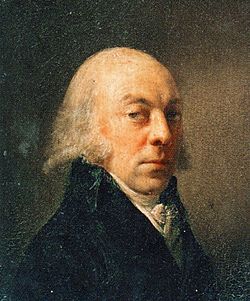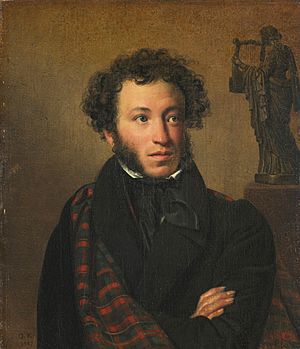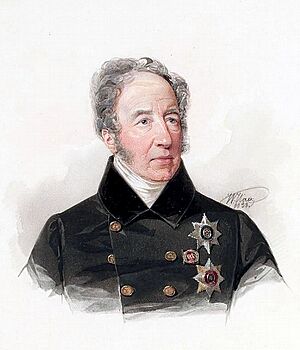Pavel Tsitsianov facts for kids
Quick facts for kids
Pavel Tsitsianov
|
|
|---|---|
|
Pavle Dimitris dze Tsitsishvili
|
|

Portrait of Tsitsianov
|
|
| Military Commander of Georgia / Viceroy of the Caucasus | |
| In office 1802–1806 |
|
| Personal details | |
| Born | 19 September 1754 Moscow, Russian Empire |
| Died | 20 February 1806 (aged 51) Baku, Caucasus Viceroyalty, Russian Empire (present-day Azerbaijan) |
| Resting place | Sioni Cathedral, Tbilisi, Georgia |
| Awards | Weapons: Gold Sword for Bravery |
| Military service | |
| Rank | General of the Infantry |
| Unit | Preobrazhensky Regiment of the Imperial Guard |
| Commands | Several Russian expeditions and armies Commander in chief of the Caucasian Viceroyalty |
| Battles/wars |
|
Prince Pavel Dmitriyevich Tsitsianov (Russian: Па́вел Дми́триевич Цициа́нов), also known as Pavle Dimitris dze Tsitsishvili (Georgian: პავლე ციციშვილი; 19 September 1754—20 February 1806), was a Georgian nobleman and a famous general in the Imperial Russian Army. He served in the Russo-Persian War of 1804-1813. From 1802 to 1806, he was the Russian Commander-in-chief in the Caucasus. Tsitsianov was known for his very strict military approach. He had strong negative feelings towards some groups, like the Circassians, whom he called "untrustworthy." He wanted to show them how powerful Russia was.
Contents
Early Life and Military Career
Pavel Tsitsianov was born into the noble Tsitsishvili family in Georgia. His father was Dimitri Pavles dze Tsitsishvili, and his mother was Elizabeth Bagration-Davitashvili. His grandfather, Paata, moved to Russia in the early 1700s. He was part of a group of Georgian nobles who went with the exiled Georgian king Vakhtang VI. Pavel also had a younger brother named Mikhail Dmitrievich Tsitsianov, who became a Senator in the Russian Empire.
Tsitsianov started his military career in 1772 in the special Preobrazhensky Regiment of the Imperial Guard (Russia). This was a very important and skilled military unit. In 1786, he became a Colonel of a Grenadier regiment. This is when his important career began during the Russo-Turkish War (1787–92) under Catherine the Great. In this war, he fought in several key battles, including Khotin, on the Salchea River, at Ismail, and Bender.
In 1796, Empress Catherine wanted to punish Persia for invading Georgia. She sent Tsitsianov as part of the Persian Expedition of 1796. This mission was led by Count Valerian Zubov. After the mission had mixed results, and after the Empress died, there was some confusion under the new ruler, Emperor Paul I. Tsitsianov decided to leave the army for a short time. However, he returned to service when Alexander I became Emperor.
Leading Russia in the Caucasus
In 1802, Tsitsianov was chosen to be the Governor General of Eastern Georgia, which Russia had recently taken over. His time as governor was known for his very strict rules for the local people. For example, he sent the remaining members of Georgia's old royal family to Russia.
Despite his strictness, he completed important projects. He improved the Georgian Military Road, which was a key route. He also led Russian armies to early victories in the Russo-Iranian War of 1804-1813. In Persian, people often called him "Sisianov" or "Zizianov." His title, "the Inspector," was pronounced as "Ispokhdor" in Azeri Turkish. Many Iranians used this title for him.
Historians say that Tsitsianov started a new period of harsh military actions. These actions led to the Russo-Persian War (1804-1813). He had very strong negative feelings towards Muslims and especially towards "Persians." He disliked many things connected to Iran. A clear example of his methods was the capture of Ganja in early 1804. Tsitsianov's capture of Ganja was very harsh. The city was badly damaged, and its governor, Javad Khan, his son, and many defenders were killed.
Even though many people did not like his policies, Tsitsianov's rule brought some much-needed stability to Georgians. He was especially good at stopping the frequent attacks and raids by mountain people called Lezgians. When one of his generals was killed fighting the Lezgians, Tsitsianov became very angry. He wrote a strong letter to the Sultan of Elisu, telling him that he expected loyalty to the Russian Emperor. Later, under orders from Emperor Alexander I, he led Russian armies into the new Russo-Persian War (1804–13). In the summer of 1804, he moved against Persian forces in Persian Armenia. He fought battles at Gyumri, Echmiadzin, on the Zang River, and finally Yerevan. For his actions, he received the Order of St. Vladimir, 1st Degree.

Death and Legends
In 1806, Tsitsianov bravely rode to the walls of Baku. He was there for a ceremony to officially hand over the city to Russian rule after a successful siege. As the general was about to receive the keys to the city, soldiers loyal to the Khan of Baku suddenly shot him and his Georgian aide, Elisbar Eristov. Tsitsianov's head and both hands were cut off. The third person in their small group managed to escape and tell the terrible story. Tsitsianov's head was sent to Fat′h-Ali Shah Qajar in Tehran.
There is a story related to this event. In 1806, Mirza Mohammad Akhbari, a religious teacher in Tehran, supposedly promised Fat′h-Ali Shah Qajar that he could cause Tsitsianov's death using supernatural powers. He went to a shrine at Shah-Abdol-Azim for forty days and performed some magical practices. However, Fat′h-Ali Shah worried that Mirza's powers might be used against him. So, he sent Mirza away to Arab Iraq.
Images for kids
See also
 In Spanish: Pável Tsitsiánov para niños
In Spanish: Pável Tsitsiánov para niños


